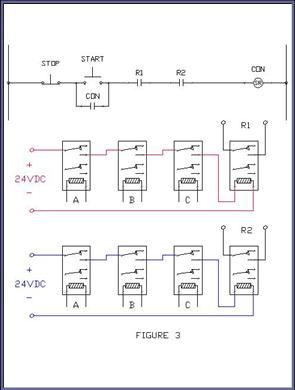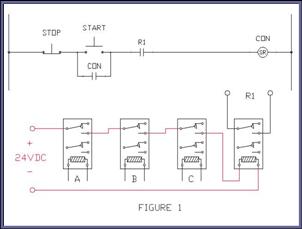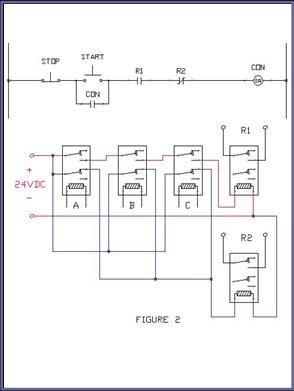
|
|
|
Safety Circuits, Force Guided vs. General Purpose Relays.
By Robert Anderson, BSEE
|
These are all questions that I found myself asking at the beginning of my last project. I've been away from control system design for a few years now, designing software in the interim, and what I found is that safety circuits are more critical and taken more seriously than they were even a few years ago.
There are categories of safety circuits now, (perhaps there were ten years ago too, and I was unaware of them) Category B, 1, 2, 3 and 4. Which indicate, not necessarily the level of safety (as some people think), but how the safety problem is approached. Although a category 4 circuit is generally viewed as more safe than a category 2, this may not be the case. Regardless, that's a topic for another paper, my focus for this paper is the problem that I was confronted with, which was essentially a logic problem using relays for safety. I had a situation where I needed to use quite a few relays to make a safety circuit that was failsafe. I will be speaking of "Force Guided Relays" and a possible alternative to them, General Purpose Relays.
Now, when I started the project I knew little about Force Guided Relays. Unlike traditional relays, the force guided variety don't have a long lever arm for the contact arm. The force acting on a general purpose relay is near the fulcrum of the arm. With a force guided relay, the force acting on the relay is about as close to the contact point as one can reasonably get. This arrangement puts more force on moving a "sticky" contact apart than the traditional variety. Traditional general purpose relays are more likely to "spring" away from a stuck contact, while the force guided relays are actually pushed (or pulled) away. Force guided relays are guaranteed, that when they do stick, they can never have both a normally open and normally closed condition simultaneously. So, the one stuck contact keeps any other contacts whether normally open or normally closed from changing states. Force guided relays are slower. Force guided relays are more likely to stick. Force guided relays wear out quicker. These are facts as I understand them.
I began wondering during my project if it might not be a disadvantage, rather than an advantage of the force guided relays that they are guaranteed not to have a NO and a NC condition simultaneously. Using a normal general purpose relay, using all NO contacts, pole #1 could be open, while at the same time pole #2 could be closed. This is clearly a faulty state. But, could this be to our advantage? Let's design a simple logic circuit.
|
|
|
|
 Using
force guided relays, we essentially must have two relays for
each logic variable. It is insufficient to wire the A variable, say,
through pole #1 and pole #2 of the same relay (even though I have seen
this), because of the guarantee of the force guided relays. If one
contact welds shut, all contacts will follow suite, either normally
open or normally closed as the case may be. So, by definition, if pole
#1 NO contact welds shut, pole #2 NO contact will also still be
conducting. Our goal is this: if any one relay goes bad, our safety
circuit must detect it. So, to accomplish this we must have two
separate circuits, each identical to the other one. Then in the
circuit that we are trying to inhibit, we use both R's, in a series
circuit, or R1 . R2, which makes this circuit failsafe. Using
force guided relays, we essentially must have two relays for
each logic variable. It is insufficient to wire the A variable, say,
through pole #1 and pole #2 of the same relay (even though I have seen
this), because of the guarantee of the force guided relays. If one
contact welds shut, all contacts will follow suite, either normally
open or normally closed as the case may be. So, by definition, if pole
#1 NO contact welds shut, pole #2 NO contact will also still be
conducting. Our goal is this: if any one relay goes bad, our safety
circuit must detect it. So, to accomplish this we must have two
separate circuits, each identical to the other one. Then in the
circuit that we are trying to inhibit, we use both R's, in a series
circuit, or R1 . R2, which makes this circuit failsafe.
As can be seen, the circuit with the force guided relays requires 8 relays to be made safe, while the circuit utilizing general purpose relays requires only 5. Add to that the cost of a force guided relay with socket is in the neighborhood of $50 each (but up to several hundred dollars), while a general purpose relay can be purchased for as little as $7 each (more typically $15). So, the hardware cost to implement is $400 vs. $35. |
Of course this is a very simple, made up situation, but reality may not be far removed. It is possible to take any logical safety circuit and using Boolean logic come up with its negative circuit, i.e., one that will always be off when it is on and vice versa. In so doing, a person can always use the unused poles of their general purpose relay for the task and avoid a costly redundant circuit using a full set of redundant force guided relays.
Robert Anderson, BSEE
www.atsi.cc
 Let's
use a simple start-stop circuit, pulling in a contactor. We'll
just say that A, B and C must all be true as a condition for our
circuit, and we'll call the result R1. Put another way,
Let's
use a simple start-stop circuit, pulling in a contactor. We'll
just say that A, B and C must all be true as a condition for our
circuit, and we'll call the result R1. Put another way, What if we now build the exact negative of this circuit? It would be:
A + B + C = R1 = R2, where the bar through the letter indicates the
NOT condition. (See figure 2 to the right. The red wires are the
original circuit and the blue wires represent the negative circuit).
So, to implement the first circuit with general purpose relays, we
need 4 relays. To implement the second circuit, we also need 4 relays,
but if we use the NO contacts for circuit 1 and the NC contacts for
circuit 2, we can reuse the first 3 relays and only need one
additional relay! We then use R1 and R2 in our start-stop circuit that
we are building. If any contact welds shut, the circuit will
immediately fail, because we will either get both R contacts being
open or both R contacts being closed'. failsafe. So, in fact we use
the very fault of the general purpose relays to our advantage. When
one contact becomes stuck, the other contacts are not affected, and
still work properly.
What if we now build the exact negative of this circuit? It would be:
A + B + C = R1 = R2, where the bar through the letter indicates the
NOT condition. (See figure 2 to the right. The red wires are the
original circuit and the blue wires represent the negative circuit).
So, to implement the first circuit with general purpose relays, we
need 4 relays. To implement the second circuit, we also need 4 relays,
but if we use the NO contacts for circuit 1 and the NC contacts for
circuit 2, we can reuse the first 3 relays and only need one
additional relay! We then use R1 and R2 in our start-stop circuit that
we are building. If any contact welds shut, the circuit will
immediately fail, because we will either get both R contacts being
open or both R contacts being closed'. failsafe. So, in fact we use
the very fault of the general purpose relays to our advantage. When
one contact becomes stuck, the other contacts are not affected, and
still work properly.